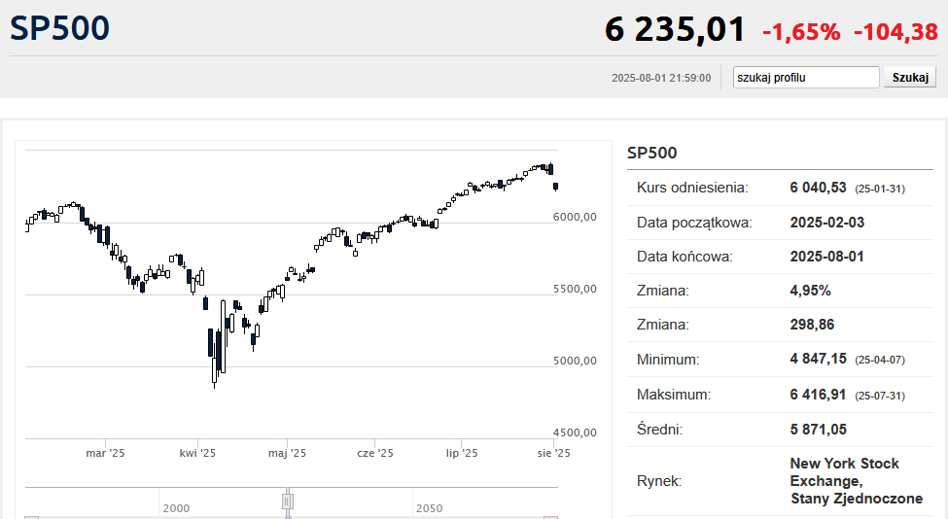Wall Street sees sharp declines. Tariffs or just profit-taking?

Friday's session on the New York Stock Exchange brought strong declines in the main indices. The official explanation was the increase in tariffs for some US trading partners and poor data from the US market work. Nuclear threats between the US and Russia did not help either.

The S&P500 closed the first session of August at 6,238.01 points, which meant a drop of 1.60%. The Nasdaq fell by 2.24%, reaching height of 20,650.13 points. Dow Jones gave up 1.23% and finished with a result of 43,588.58 pt.
In the market comments, most space was devoted to new tariffs announced by the Donald Trump administration . President Trump Canada and Switzerland have been given a solid hand , although most of the main partners America's trade received 15 percent tariffs. It's hard to say whether such decisions were not liked by the markets that much, or were they used as an excuse to realize the considerable profits from the previous four months.
AdvertisementMoods The weak US labor market report didn't improve things . It didn't improve things, although it should have. Because it revived hopes for a September rate cut. interest rates at the Federal Reserve. After such weak payrolls, the market forward rate estimates the chances of a 25-basis-point cut in the federal funds rate at the September FOMC meeting at over 80%. Just a day earlier, the valuation of such a scenario was less than 38%. Theoretically (but also often in practice) lower discount rates lead to higher stock and bond valuations.
Another piece of bad news was the escalation of tension on the line Russia-United States. President Trump issued order to deploy two nuclear-powered submarines in "appropriate areas" in response to the former president's provocative threats Dmitry Medvedev's Russia. Even if the likelihood of a nuclear confrontation between two nuclear powers is very low, it is for the markets financial, this means a new, previously undervalued risk factor.
In addition, investors may experience feelings déjà vu. That's exactly it. a year ago miserable report from the American labor market combined with a somewhat surprising interest rate hike at the Bank of Japan caused a small crash in the financial markets . Although this time the Japanese did not They started, but just like a year ago, global stock markets have seen solid gains and some investors may have gained a false sense of security.
- A year ago, the Fed screwed up by not cutting rates in July and then they had to make up for it in September (when he lowered rates immediately by 50 basis points – editor's note). They will probably do the same in this year, Brian Jacobsen, chief economist at Annex, told Reuters Wealth Management.
Moreover, the pressure on Fed Chairman Jerome Powell continues President Donald Trump will exert pressure. After failing to cut interest rates as expected, at the July FOMC meeting, Trump called Powell a "stubborn moron." Two other people also spoke out against Powell. Federal Reserve board members who voted for a 25-point reduction in the federal funds rate.
- I think the "wait and see" approach is too cautious and in my opinion it does not properly balance the risks to the economic outlook, which may result in the monetary policy response being delayed - he wrote in statement by Christopher Waller, one of the two July "dissidents." In turn, Michelle Bowman, who also wanted to cut costs, pointed out the weakness of the labor market feet already in July.
On Friday, investors sold mainly stocks tech giants. Amazon's stock price plunged by over 8% after like a giant e-commerce disappointed with its forecasts for the current quarter . Investors expected more from Amazon's cloud business (AWS). They lost over 3% Meta's shares, which the day before were riding on the wave of excellent quarterly results grew by over 11%.
It is worth remembering that the New York Stock Exchanges have a very long history power period. From the April low to the July peak, the S&P500 grew by as much as 32%. The Nasdaq gained over 44% during the same period. Therefore, the profits on the table may tempt you to implement them and deepen Friday's sell-off. that the beginning of August is statistically a weak period for the American market shares. Some kind of correction after such a long period of practically non-existent variability would be as desirable as a good downpour after a hot day.

bankier.pl







